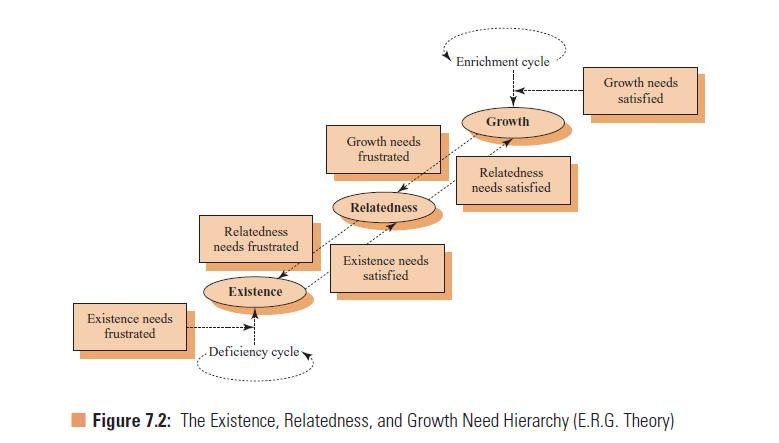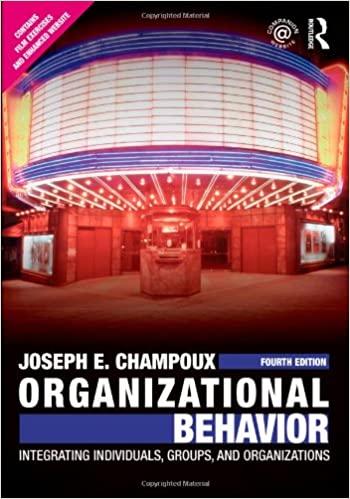Discuss the similarities and differences between Maslows hierarchy of needs theory and E.R.G. theory. What insights do
Question:
Discuss the similarities and differences between Maslow’s hierarchy of needs theory and E.R.G. theory. What insights do you gain from each theory?
Maslow’s hierarchy of needs Theory:
Murray’s theory showed that needs are an essential and powerful force directing human behavior. In contrast with Murray and his long list of needs, Abraham H. Maslow felt that needs could be put into five groups of basic human needs that all healthy adults try to satisfy. Maslow felt those needs are so basic that they motivate the behavior of people in many different cultures. Chronic frustration of those needs could produce psychopathological results.
E.R.G. THEORY
E.R.G. theory extends Maslow’s theory. Many aspects of the theory are similar to Maslow’s theory, but other aspects are unique and insightful about the effects of needs on human behavior.
E.R.G. theory describes three groups of basic human needs: existence, relatedness, and growth. Existence needs are a person’s physical and material wants. Relatedness needs are the same as belongingness and love needs.
Growth needs are the desires to be creative and productive, to use skills, and to develop additional capabilities. These three groups of needs form a hierarchy: existence, relatedness, growth. All people have these needs, although in varying degrees. Figure 7.2 shows the structure of E.R.G. theory.
Note the similarities between E.R.G. theory and the hierarchy of needs theory. Existence needs are the same as physiological and safety needs. Relatedness needs are the same as belongingness and love needs. Growth needs include both esteem and self-actualization needs.
In E.R.G. theory, needs affect an individual’s behavior in much the same way as described by Maslow. An unsatisfied need is a motivator. If both lower-order and higher-order needs are unsatisfied, the lower-order needs will be the most important motivators of behavior.
Movement through the need hierarchy is both similar to and different from Maslow’s description. Satisfaction of a need leads to upward movement in the hierarchy. Frustration of a need leads to downward movement in the hierarchy. The first form of movement is satisfaction–progression, which is the same as described for Maslow’s hierarchy of needs theory. The second form of movement is frustration–regression, a concept introduced by E.R.G. theory that gives additional insight about motivation and human behavior. Here is an illustration of the two forms of movement.
Assume you are seeking a promotion at work and apply for a new position. Many others have applied, but only one person will be selected. The people who work with you strongly support you for the promotion. Working hard for the promotion implies you have strong growth needs that you are trying to satisfy by getting the promotion. After a prolonged wait, you learn you have not been selected. Your growth needs are now frustrated. E.R.G. theory predicts you will move down the hierarchy and focus on relatedness needs. In this situation, you will turn to your coworkers for further support while adjusting to the disappointment of not being promoted. If your growth needs are strong, however, sometime in the future you will turn to satisfying them again.
Two other concepts in E.R.G. theory extend beyond Maslow’s hierarchy of needs theory. A person can become locked into a deficiency cycle at the bottom of the hierarchy. An individual who cannot satisfy his existence needs will more strongly desire to satisfy those needs. Under conditions of scarcity, a person could become obsessed with satisfying existence needs.
A different cycle operates at the top of the hierarchy. A person who successfully satisfies growth needs desires them even more. This enrichment cycle leads a person to want to continually grow and develop. The individual will also seek multiple environments to satisfy his needs for growth. For example, an individual who is successful in a challenging and demanding job should experience the enrichment cycle. He will continue to seek challenges in activities away from work such as leading a community group or playing competitive sports.
Empirical research supports many parts of the E.R.G. theory, but not all. The elements of the theory that have the most important implications for management received the most support. Progression and regression were supported, but movement through the hierarchy was not as simple and clear cut as originally thought. The research showed some thresholds in need satisfaction levels are related to movements in either direction. The enrichment cycle had empirical support, especially in settings that offered challenge and discretion. A person with an intensified desire for growth could also seek growth satisfaction in more than one setting.
Step by Step Answer:

Organizational Behavior Integrating Individuals Groups And Organizations
ISBN: 9780415804646
4th Edition
Authors: Joseph E. Champoux





